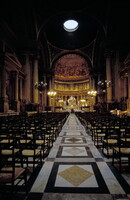| dc.coverage.spatial | Site: Paris, Île-de-France, France | en_US |
| dc.coverage.temporal | consecrated 1842 (other); designed 1807 (design) | en_US |
| dc.creator | Vignon, Pierre | en_US |
| dc.date | 1842 | en_US |
| dc.date.accessioned | 2013-01-25T21:47:44Z | |
| dc.date.available | 2013-01-25T21:47:44Z | |
| dc.date.issued | 1842 | en_US |
| dc.identifier | 186503 | en_US |
| dc.identifier.other | archrefid: 1653 | en_US |
| dc.identifier.uri | http://hdl.handle.net/1721.3/95697 | |
| dc.description | From 1806 Vignon concentrated on completing the Madeleine, a church that had remained unfinished since the days of the ancien régime. In 1806 Napoleon ordered that a Temple de la Gloire de la Grande Armée should be erected there and Claude-Etienne Beaumont (1757-1811) emerged as winner of the limited competition (1807), but he was superseded by Vignon on Napoleon’s orders. He designed a vast peripteral Corinthian temple, with a single huge, barrel-vaulted interior, to form a counterpart to the distant Chambre des Députés by Bernard Poyet. Building work, however, never started; in 1815, Louis XVIII contemplated using the site for the Chapelle expiatoire dedicated to Louis XVI and another competition was held (1816), to which Vignon contributed. The enterprise was judged too expensive and it was decided to build the Madeleine as a parish church. Vignon retained the commission using his designs of 1807, subject to modifications, which included roofing the nave with three domes. The masonry of the exterior was virtually finished by 1828 when Vignon died, and the completion of the interior (1828-1842) was supervised by Jean-Jacques Huvé (1783-1852).; From 1806 Vignon concentrated on completing the Madeleine, a church that had remained unfinished since the days of the ancien régime. In 1806 Napoleon ordered that a Temple de la Gloire de la Grande Armée should be erected there and Claude-Etienne Beaumont (1757-1811) emerged as winner of the limited competition (1807), but he was superseded by Vignon on Napoleon’s orders. He designed a vast peripteral Corinthian temple, with a single huge, barrel-vaulted interior, to form a counterpart to the distant Chambre des Députés by Bernard Poyet. Building work, however, never started; in 1815, Louis XVIII contemplated using the site for the Chapelle expiatoire dedicated to Louis XVI and another competition was held (1816), to which Vignon contributed. The enterprise was judged too expensive and it was decided to build the Madeleine as a parish church. Vignon retained the commission using his designs of 1807, subject to modifications, which included roofing the nave with three domes. The masonry of the exterior was virtually finished by 1828 when Vignon died, and the completion of the interior (1828-1842) was supervised by Jean-Jacques Huvé (1783-1852). Source: Grove Art Online; http://www.oxfordartonline.com/ (accessed 12/16/2008) | en_US |
| dc.format.medium | stone | en_US |
| dc.rights | © Scott Gilchrist, Archivision, Inc. | en_US |
| dc.subject | architectural exteriors | en_US |
| dc.subject | rulers and leaders | en_US |
| dc.subject | Napoleon I, Emperor of the French, 1769-1821 | en_US |
| dc.subject | Napoleonic Wars, 1800-1815 | en_US |
| dc.subject | Neoclassical | en_US |
| dc.subject | Nineteenth century | en_US |
| dc.title | La Madeleine | en_US |
| dc.title.alternative | Église de la Madeleine | en_US |
| dc.title.alternative | L'église Sainte-Marie-Madeleine | en_US |
| dc.type | image | en_US |
| dc.rights.access | Licensed for educational and research use by the MIT community only | en_US |
| dc.identifier.vendorcode | 1A2-F-P-M-C1 | en_US |
| vra.culturalContext | French | en_US |
| vra.technique | construction (assembling) | en_US |
| vra.worktype | church | en_US |
| vra.worktype | memorial | en_US |
| dc.contributor.display | Pierre Vignon (French architect, 1763-1828) | en_US |


